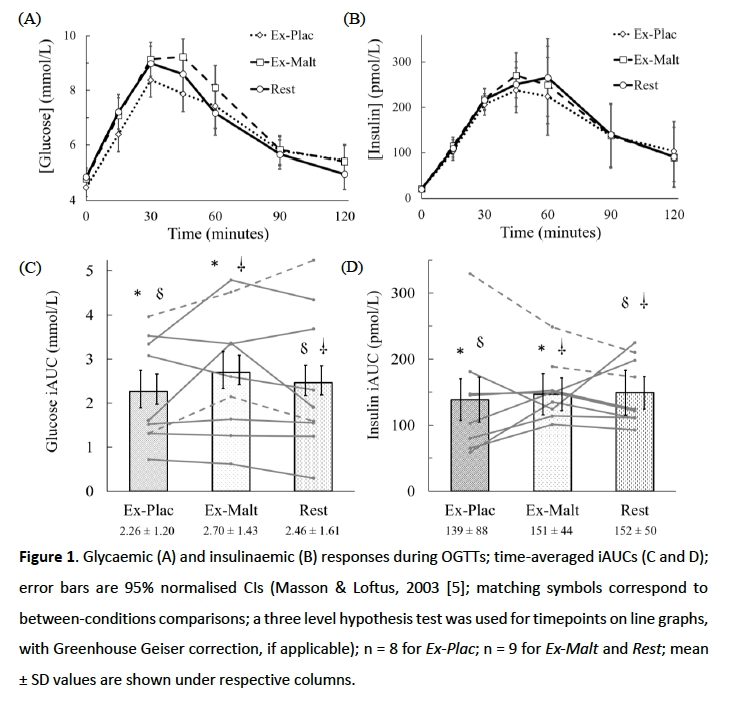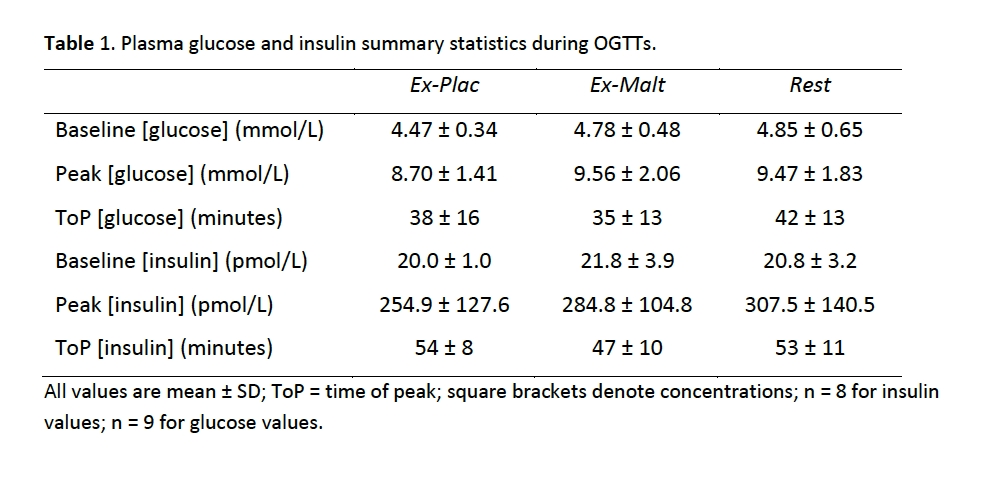The residual improvement in insulin sensitivity (IS) following individual exercise bouts is a key mechanism by which endurance exercise enhances glycaemic control (1). However, it is unclear to what extent this benefit is dictated by a negative carbohydrate (CHO) balance (greater CHO oxidation than ingestion). Supporting a regulatory role of CHO balance, Taylor et al. (2) demonstrated that the morning after 90 minutes of treadmill exercise, with or without CHO replacement, whole-body IS was reduced by 25% when CHO was replaced. However, use of a non-exercise control condition alongside CHO replete and CHO deficit exercise conditions is necessary to establish whether elimination of the exercise-induced CHO deficit partially or fully negates the acute-exercise-induced improvement in IS. Therefore, the present study compared IS and glycaemic control the morning after evening treadmill exercise, with or without CHO replacement, versus a non-exercise control. Seven males and two females (mean ±SD age: 23 ±1 years; body mass index: 24.0 ±2.7 kg/m2) completed all conditions in a randomised order, preceded by two days diet replication and exercise cessation. Conditions Ex-Plac and Ex-Malt (beginning ~16:30) involved 90 minutes of identical treadmill exercise (79% ±4% and ±6% age-predicted maximum heart rate), followed immediately by ingestion of either maltodextrin (Ex-Malt; 200 or 150 g for males and females, respectively) or taste-matched placebo (Ex-Plac). Rest involved seated rest with no drink. After evening visits, participants consumed nothing but water and a prescribed low CHO dinner (55, 441 and 178 kcal from CHO, fat and protein, respectively) until an oral glucose (75 g) tolerance test undertaken the following morning (~14 hours after evening visits), to assess glycaemic control and whole-body IS. Plasma glucose and insulin were assessed using a spectrophotometric analyser (Randox Daytona, Crumlin, UK) and enzyme-linked immunosorbent assays (Mercodia AB, Uppsala, Sweden), respectively. Data are: mean ∆ (95% confidence intervals). While there were only minor differences in glycaemic and insulinaemic responses between conditions (Figure 1), both the Matsuda insulin sensitivity index (ISIM [3]) and homeostatic model of insulin resistance (HOMA-IR [4]) were improved in Ex-Plac versus Ex-Malt, by 21% (2.2. au [0.4, 4.0]) and 13% (-0.11 au [-0.18, -0.03]), respectively (Figure 2). Data also suggested improvements in Ex-Plac versus Rest, but these differences were less clear; +16% (1.8 au [-0.3, 3.9]) in ISIM and -14% (-0.10 au [-0.22, 0.01]) in HOMA-IR. Outcomes were similar between Ex-Malt and Rest. Additional glucose and insulin summary statistics are shown in Table 1. Differences between Ex-Plac and Ex-Malt were similar to those reported by Taylor et al. (2), supporting that CHO replacement attenuates the acute, exercise-induced improvement in IS. The complete absence of improvements in Ex-Malt versus Rest indicate that any acute, endurance-exercise-induced benefit to IS in healthy populations is likely fully dependent on the presence of a negative CHO balance. Thus, extending the post-exercise CHO deficit, via maximising CHO oxidation during exercise or delaying CHO replenishment (by altering type, timing or amount of CHO intake) may reduce glycaemic or insulinaemic exposures, but intervention studies are required to test this hypothesis.
Future Physiology 2020 (Virutal) (2020) Proc Physiol Soc 46, PC0036
Poster Communications: The Role of Carbohydrate Balance in Acute, Exercise-Induced Improvements in Insulin Sensitivity in Healthy Adults.
Drusus Johnson-Bonson1, James Betts1
1 University of Bath, Bath, United Kingdom
View other abstracts by:
Where applicable, experiments conform with Society ethical requirements.



